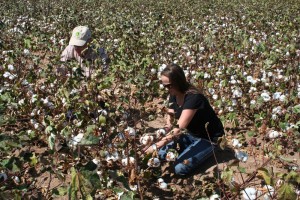Marketing Communications Team Collects Crucial Information
By John Johnson

Dick Cooper and Emma Matkin survey a field to determine its yield potential. Photo by John Johnson
Estimating the size of PCCA’s marketing pools each crop year is vitally important to ensure success based on policy set by the farmer-members of the cooperative’s pool committees. In some years, almost half of the crop may be sold before the first bale is ginned; therefore, it is important to know what the pool volume will be.
PCCA’s marketing staff study monthly reports from USDA’s National Agricultural Statistics Service and the annual certified acreage report from the department’s Farm Services Agency to help estimate the pool size. They also poll gin managers because they know more about their patrons’ crops than anyone, according to Dick Cooper, PCCA Marketing Communications Area Manager.
“The fourth piece of the puzzle is the field surveys we start conducting after the crop gets started,” said Cooper. “We work with the gin managers and our members to identify the fields we will monitor throughout the season,” he added. This year, Marketing Communications Area Managers Emma Matkin and Tanner Streety joined Cooper in performing the important task.
“Acreage abandonment is a major factor for our West Texas/Oklahoma/Kansas pool,” Cooper said. “We also take into consideration such things as economic factors and calculate heat units that are necessary for a cotton crop to mature.” Geographic distribution also is important to the effort because pool committee members are elected by district.
“We don’t trust a windshield, so we get out in the fields to look at the crop up close,” explained Cooper. Each member of the team is assigned farms, and they make field visits once each month starting in July and prepare weekly reports of their field observations for PCCA management. Just before harvest begins, they present reports indicating yield and quality potential.
Bolls are hand-harvested from a 39-inch section of a cotton row in the fields, and boll weight and size are measured. Then, they are dried and ginned, and the lint is weighed before taking it to Texas Tech University’s Institute for Fiber and Biopolymer Research where it is classed to determine quality characteristics.
“Hopefully, the data we collect gives management some peace of mind regarding the size of the pool,” Cooper added. “Our members like the fact that we care about their crop. Getting some dirt on our boots and talking to the guys we work for is the highlight of our day.”


